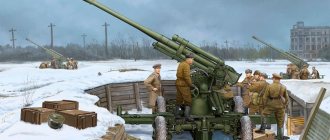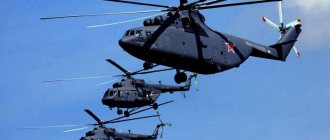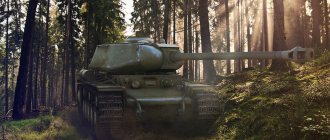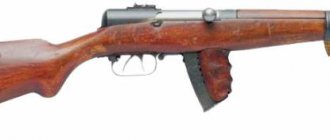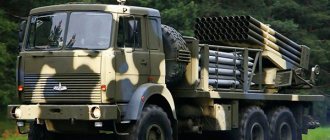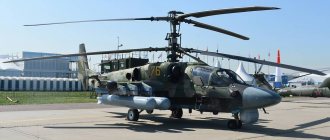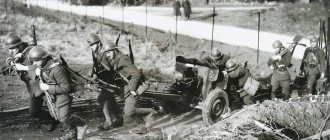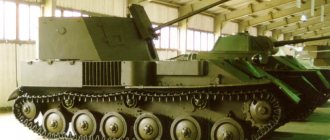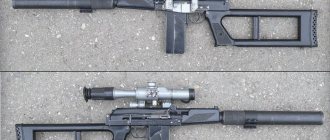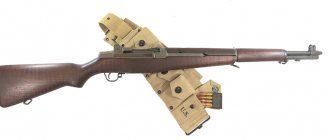| NR-23 | |
| Type | Single-barreled automatic cannon |
| A country | USSR |
| Service history | |
| In service | USSR Air Force Chinese Air Force |
| Production history | |
| Constructor | A. E. Nudelman A. A. Richter |
| Designed by | 1946—1951 |
| Manufacturer | ]No. 2[/anchor] (Kovrov) and No. 525 (Kuibyshev) |
| Years of production | 1948—1957 |
| Options | Norinco Type 23-1 and Type 23-2 |
| Characteristics | |
| Weight, kg | 39 |
| Length, mm | 2018 |
| Barrel length, mm | 1450 |
| Width, mm | 165 |
| Height, mm | 136 |
| Cartridge | 23×115 mm |
| Caliber, mm | 23 |
| Work principles | short barrel stroke |
| Rate of fire, rounds/min | 800-950 |
| Initial bullet speed, m/s | 680 |
| Type of ammunition | double-sided continuous tape |
| Media files on Wikimedia Commons | |
Two HP-23 cannons in the rear turret of the Il-28
NR-23
(Nudelman-Richter) - Soviet aircraft gun of 23 mm caliber.
Development[edit | edit code]
In 1943, OKB-16 developed a new 23 mm cartridge with a reduced charge, which was used to create several new lightweight 23 mm aircraft guns. On the basis of the 14.5 mm standard anti-tank cartridge, a new cartridge case was created by re-crimping it to a 23 mm caliber. Using a standard 23-mm projectile (VYA guns chambered for 23x152 mm) and this cartridge case, a new cartridge was created. The initial speed of a projectile weighing 200 grams in a barrel 1450 mm long was 700 m/s.
In 1944, the NS-23 aircraft cannon was developed for the new cartridge, which was used to arm the Il-10 attack aircraft, the La-9 and La-11 propeller-driven fighters, as well as the first Soviet jet fighters MiG-9, MiG-15 and Yak-15. However, due to the need to further improve the defensive weapons of the developing Soviet bomber aviation, the NS-23 guns were subject to demands for greater versatility and a symmetrical double-sided cartridge belt feeding mechanism, so already in December 1946, OKB-16 began development based on the NS-23 design of the first a prototype of such a 23-mm gun, adapted for both fixed and mobile installations. The new gun of A. E. Nudelman and A. A. Richter soon received the name NR-23
(Nudelman-Richter)[1].
The NR-23 was intended to replace the 20-mm B-20 air cannon on the Tu-4 heavy bomber when converting its defensive system to 23 mm caliber[1].
Two NR-23 cannons were mounted on the La-15 for the first time. The La-15 with new guns was put into service in 1948 (at the same time the NR-23 was put into production). The NR-23 cannon chambered for the NS-23 cartridge was officially put into service in 1950. Work on fine-tuning the NR-23 was completed in 1951 (a hydraulic buffer was introduced to reduce recoil; also, at the request of the Minister of Armaments D.F. Ustinov, the survivability of the barrel was increased from 3000 to 6000 shots during the year).
23-mm aircraft gun NR-23.
23-mm aircraft gun NR-23.
Developer: OKB-16, A.E. Nudelman and A.A. Richter Country: USSR Start of development: 1946 Adoption into service: 1950
In 1943, OKB-16 developed a new 23 mm cartridge with a reduced charge, which was used to create several new lightweight 23 mm aircraft guns. Based on the 14.5 mm standard anti-tank cartridge, a new cartridge case was created by re-crimping it to a 23 mm caliber. Using a standard 23-mm projectile (guns chambered for 23 x 152 mm) and this cartridge case, a new cartridge was created. The initial speed of a projectile weighing 200 grams in a barrel 1450 mm long was 700 m/s.
In 1944, the NS-23 aircraft cannon was developed for the new cartridge, which was used to arm the Il-10 attack aircraft, the La-9 and La-11 propeller-driven fighters, as well as the first Soviet jet fighters MiG-9, MiG-15 and Yak-15. However, due to the need to further improve the defensive weapons of the developing Soviet bomber aviation, the NS-23 guns were subject to demands for greater versatility and a symmetrical double-sided cartridge belt feeding mechanism, so already in December 1946, OKB-16 began development based on the NS-23 design of the first a prototype of such a 23-mm gun, adapted for both fixed and mobile installations.
The new gun of A.E. Nudelman and A.A. Richter soon received the name NR-23 (Nudelman-Richter).
The fundamental differences from the NS-23 cannon were double-sided belt feeding and a higher rate of fire. For this purpose, rollback and rollback accelerators were introduced. The automatic operation of the gun is based on the principle of using recoil energy with a short barrel stroke. The gun had a double-sided continuous belt feed. The ammunition was NS-23 cannon cartridges. The belt was made of steel links of the new type HP-23. The gun was secured to the installation by a casing. The front mount of the gun was a power mount, the rear mount was a support mount. Reloading is pneumatic. The channel is locked by piston.
Barrel length - 1450 mm. Gun dimensions: length - 2022 mm, width - 165 mm, height - 136 mm. The weight of the gun is 39 kg. Rate of fire - 800-950 rounds/min. The initial velocity of the projectile is 680 m/s.
For the first time, two HP-23 cannons were installed on the La-15. La-15 fighters with HP-23 cannons were put into service in 1948 and then put into production. And the HP-23 cannon itself was officially adopted for service in 1950.
Initially, the HP-23's survivability was set at 3,000 rounds for mass production. Arms Minister Ustinov demanded that OKB-16 and the plant increase survivability to 6,000 rounds within a year, which was largely achieved. To reduce recoil, a hydraulic buffer was introduced.
In 1951, work on the development of the HP-23 was completed. The guns were mass-produced from 1948 to 1956 at factories No. 2 and No. 525. In 1957, only the assembly of guns was carried out from a stock of parts.
In 1948, 280 NR-23 guns were produced, in 1949 - 1243, in 1950 - 5802, in 1951 - 12098, in 1952 - 18572, in 1953 - 16235, in 1954 - 9802, in 1955 - 6351.
Aircraft armed with the NR-23 cannon:
Tu-4 - armed with ten NR-23 cannons; La-15 - armed with three NR-23 cannons; Yak-23 - armed with two NR-23 cannons; MiG-15bis - armed with two HP-23 and one N-37 cannons; MiG-17 - armed with two NR-23 and one N-37 cannons (except for the MiG-17PFU, which did not have cannon armament. The MiG-17PF had three NR-23 cannons); MiG-19 - the first production version of the MiG-19 was armed with three NR-23 cannons. The MiG-19P interceptor had two NR-23 cannons; Il-10 - the last production version of the Il-10M attack aircraft was armed with four NR-23 cannons installed in the wing consoles; Il-28 - two NR-23 cannons along the sides at the bottom of the bow and two NR-23 in the aft defensive turret; An-12 - two NR-23 cannons in the rear defensive turret; Be-6 - armed with five NR-23 cannons, one in the N-2 bow mount, two in the deck DT-V8 and two in the aft turret.
The modified NR-23 was planned to be installed on the Soviet military orbital stations "Almaz".
Specifications:
Manufacturer: plants No. 2 (Kovrov) and No. 525 (Kuibyshev) Caliber, mm: 23 Cartridge, mm: 23 x 115 Gun length, mm: 2022 Gun width, mm: 165 Gun height, mm: 136 Barrel length (barrels), mm: 1450 Gun weight without magazine, kg: 39 Rate of fire, rds/min: 950 Initial projectile speed, m/sec: 680 Number of barrels: 1 Operating principles: short recoil of the barrel.
Aviation cannon NR-23.
.
.
Source: A.B. Shirokorad. History of aviation weapons.
Design[edit | edit code]
HP-23 (in the background) in comparison with the N-37 (in the foreground) in the Dresden Bundeswehr Museum.
The fundamental differences between the HP-23 and its predecessor were double-sided belt feed and a higher rate of fire (up to 800-950 rounds/min.) . For this purpose, rollback and rollback accelerators were introduced. The automatic operation of the gun is based on the principle of using recoil energy with a short barrel stroke. The gun had a double-sided continuous belt feed. The double-sided cartridge feed mechanism greatly simplified the installation of the gun on an aircraft, making it universal for mobile and fixed installations. For a number of years, the HP-23 cannon was the main weapon of both bomber and fighter aircraft. The Tu-4, MiG-15bis, Tu-14 and a number of others were armed with it.
NR-23
In 1943, OKB-16 developed a new 23 mm cartridge with a reduced charge, which was used to create several new lightweight 23 mm aircraft guns. On the basis of the 14.5 mm standard anti-tank cartridge, a new cartridge case was created by re-crimping it to a 23 mm caliber. Using a standard 23-mm projectile (VYA guns chambered for 23x152 mm) and this cartridge case, a new cartridge was created. The initial speed of a projectile weighing 200 grams in a barrel 1450 mm long was 700 m/s.
In 1944, the NS-23 aircraft cannon was developed for the new cartridge, which was used to arm the Il-10 attack aircraft, the La-9 and La-11 propeller-driven fighters, as well as the first Soviet jet fighters MiG-9, MiG-15 and Yak-15. However, due to the need to further improve the defensive weapons of the developing Soviet bomber aviation, the NS-23 guns were subject to demands for greater versatility and a symmetrical double-sided cartridge belt feeding mechanism, so already in December 1946, OKB-16 began development based on the NS-23 design of the first a prototype of such a 23-mm gun, adapted for both fixed and mobile installations. The new gun of A. E. Nudelman and A. A. Richter soon received the name NR-23
(Nudelman-Richter)[1].
The NR-23 was intended to replace the 20-mm B-20 air cannon on the Tu-4 heavy bomber when converting its defensive system to 23 mm caliber[1].
Two NR-23 cannons were mounted on the La-15 for the first time. The La-15 with new guns was put into service in 1948 (at the same time the NR-23 was put into production). The NR-23 cannon chambered for the NS-23 cartridge was officially put into service in 1950. Work on fine-tuning the NR-23 was completed in 1951 (a hydraulic buffer was introduced to reduce recoil; also, at the request of the Minister of Armaments D.F. Ustinov, the survivability of the barrel was increased from 3000 to 6000 shots during the year).
The fundamental differences between the HP-23 and its predecessor were the double-sided belt feed and a higher rate of fire (up to 800-950 rounds per minute). For this purpose, rollback and rollback accelerators were introduced. The automatic operation of the gun is based on the principle of using recoil energy with a short barrel stroke. The gun had a double-sided continuous belt feed. The double-sided cartridge feed mechanism greatly simplified the installation of the gun on an aircraft, making it universal for mobile and fixed installations. For a number of years, the HP-23 cannon was the main weapon of both bomber and fighter aircraft. The Tu-4, MiG-15bis, Tu-14 and a number of others were armed with it.
The guns were mass-produced from 1948 to 1956 at factories No. 2 and No. 525 (now OJSC Metallist-Samara). In 1957, only guns were assembled from spare parts. In 1948, 280 HP-23 guns were produced, in 1949 - 1243, in 1950 - 5802, in 1951 - 12098, in 1952 - 18572, in 1953 - 16235, in 1954 - 9802, in 1955 - 6351. A total of 70383 NR-23 aircraft guns were manufactured.
Two HP-23 cannons in the rear turret of the Il-28
HP-23 (in the background) compared with the H-37 (in the foreground) at the Dresden Bundeswehr Museum
Production[edit | edit code]
The guns were mass-produced from 1948 to 1956 at factories No. 2 and No. 525 (now OJSC Metallist-Samara). In 1957, only guns were assembled from spare parts. In 1948, 280 HP-23 guns were produced, in 1949 - 1243, in 1950 - 5802, in 1951 - 12098, in 1952 - 18572, in 1953 - 16235, in 1954 - 9802, in 1955 - 6351. A total of 70383 NR-23 aircraft guns were manufactured.
Licensed production[edit | edit code]
The NR-23 was produced under license in the People's Republic of China under the Norinco designation "Type 23". They were armed with J-5, J-6 fighters, Q-5 attack aircraft and H-6 bombers.
Aircraft armed with the NR-23 cannon[edit | edit code]
- Tu-4
: Armed with ten NR-23 cannons. - La-15
: Armed with three NR-23 cannons. - La-168
: Armed with two NR-23 cannons - Yak-23
: Armed with two NR-23 cannons. - Yak-28
: first series. He was armed with an NR-23 cannon. - MiG-15bis
: Armed with two NR-23 and one N-37 cannons - MiG-17
: Armed with two NR-23 and one N-37 cannons (except for the MiG-17PFU, which did not have cannon armament. The MiG-17PF had three NR-23 cannons). - MiG-19
: The first production version of the MiG-19 was armed with three NR-23 cannons. The MiG-19P interceptor had two NR-23 cannons. - Il-10
: The last production version of the Il-10M attack aircraft was armed with four NR-23 cannons installed in the wing consoles. - Il-28
: Two NR-23 cannons along the sides at the bottom of the bow and two NR-23 in the aft defensive turret. - Be-6
: Armed with five NR-23 cannons, one in the N-2 bow mount, two in the deck DT-V8 and two in the aft turret.
23-mm USSR air guns, NS-23; NR-23
Home » Books on the history of aviation » 23-mm USSR air guns, NS-23; NR-23
Books on the history of aviation Little-known and unrealized projects of aircraft and other flying equipment
Evgeny Aranov 05/03/2017 1580
0
in Favoritesin Favoritesfrom Favorites 0
The Soviet 23-mm VYa air cannon, developed before the war, was perhaps the best in its class - powerful, rapid-fire, trouble-free, fairly light and technologically advanced. It became the basis for the armament of the most popular aircraft of all time, the Il-2 attack aircraft. However, for all its qualities, it had too much recoil force. The fact is that in the pre-war years, the new unitary cartridge 23x152V developed, used in the VYa cannon, turned out to be too powerful. In an attempt to create a unified artillery system, equally suitable for both offensive weapons of fighters and attack aircraft, none of the leadership of the NKAP and AU thought about the other side of the power of ammunition - the inevitable recoil affecting the airframe structure of the aircraft where the gun was to be installed. Meanwhile, the recoil force of the VYa cannon reached, according to various sources, from 2.5 to 4 tons. Very, very significant for designs of the late 30s, early 40s. As a result, attempts to install a VYa cannon in the camber of fighter engines were not successful, being only experimental in nature.
Already during the war, it became obvious that domestic fighter aircraft remained under-equipped. The basis of the offensive weapons of our Yaks and La was the fast-firing, but extremely heavy ShVAK cannon, which fired very weak cartridges. The program for creating a more advanced 20-mm cannon, launched already during the war, only partially solved the problem - developing a new, more powerful 20-mm cartridge in wartime conditions was unthinkable, so competitive work on new 20-mm systems did not solve the issue of weapon power, assuming using the same weak ShVAK ammunition.
In this regard, at the beginning of 1943, OKB-16, which after the death of Ya.G. Taubin was headed by his longtime colleague and associate Alexander Emmanuilovich Nudelman, and a number of works were undertaken to create a new, more powerful aviation system. It must be said that the approach to the issue, although it had the character of a kind of wartime improvisation, ultimately turned out to be very successful.
As noted above, organizing the production of fundamentally new ammunition in a war economy was extremely difficult and expensive. These are dozens of units of stamping equipment combined into an automatic line. Not only does this equipment require lengthy debugging, but the resulting cartridge must also be made to work flawlessly in the new automatic artillery system developed for it. Anticipating these difficulties, the OKB-16 team took a simple path, combining the industrially proven cartridge case of a powerful 14.5x114 anti-tank rifle cartridge with a 23-mm projectile from the VYa cartridge, for which the neck of the 14.5-mm cartridge case was simply increased in diameter by introducing it into the production line ready-made stamps for the additional dispensing operation. The resulting ammunition, known as 23x115 mm, retained the excellent ballistics of the VYa projectile with great destructive power, but at the same time the relatively small powder charge for such a caliber made it possible to obtain moderate recoil parameters for potential weapons developed for this cartridge.
In parallel with the development of ammunition, OKB-16 began work on an aircraft cannon, which had the factory designation “115P”. Deputy A.E. became the main designer of the gun. Nudelman is a talented self-taught designer Alexander Stepanovich Suranov. The development group also included G. Zhirnykh, V. Nemenov, S. Lunin, M. Bundin.
The “115P” gun repeated the design of the previously developed 37-mm NS-37 cannon, which was proportionally reduced in size, in turn, conceptually being a modified design of the pre-war work of G.Ya. Taubin, primarily the 23-mm PTB-23 cannon.
The gun's automation operated on the basis of a short (90 mm) recoil of the barrel; the chamber was locked by turning the bolt. Charging is electro-pneumatic, for which two pneumatic cylinders were used. The first one moved the bolt back, compressing the return spring, the second compressed the receiver spring. Both cylinders were turned on simultaneously through a solenoid valve.
The damping of the recoil of the bolt was carried out by a spring-hydraulic buffer. To increase the technical rate of fire, a roll-up accelerator was used. To simplify the design of the gun, an interesting system was used to extract the spent cartridge case - when the bolt moved, it was pushed out by a new cartridge. A separate extractor was not used. Ammunition was supplied using loose metal tape only on the left side.
The design worked out on the previous project of the 37-mm NS-37 cannon allowed A.S. When developing the 23-mm 115P gun, Suranov avoided a lengthy process of trial and error. The gun turned out to be very compact and light for its class - the body weight of the gun was only 37 kg with a length of less than 2 meters, a width of 165 mm and a height of 256 mm. The barrel, 1450 mm long and weighing 13.2 kg, had 10 right-hand rifling with a depth of 0.35 mm and a width of 4.825 mm. The angle of rise of the turns is 5 degrees. 12'. The moderate power of the projectile was a consequence of the relatively low characteristics of the gun - the initial velocity of the projectile was about 690 m/s. The rate of fire, which initially reached 700 rounds/min, was artificially limited to 600 rounds/min for the sake of reliability.
Ground government tests of the gun took place from November 1943 to May 1944, already under the designation NS-23 - Nudelman-Suranov, 23 mm. In parallel, comparative tests were carried out on similar systems from competing design bureaus - the 23-mm S.V. air cannon. Vladimirov V-23, developed at OKB-2 as an enlarged version of the 14.5-mm KPV machine gun, as well as the development of OKB-15 Sh-23 by B. G. Shpitalny. However, in terms of the set of characteristics, competing developments were significantly inferior to the OKB-14 product, and also lagged behind in terms of development time.
23 mm NS-23 cannonOn May 4, 1944, ground tests of the NS-23 gun were completed, and on June 7, 1944, flight tests of the gun installed in the motor version on the Yak-9UT fighter were completed. After which, on October 10, 1944, by decision of the State Defense Committee, the NS-23 and its cartridge were adopted for service with the organization of production at plant No. 2 in Kovrov.
By the end of 1944, about 300 guns were produced, and in 1945, another 600 pieces. The initial version of the gun included only wing and motor versions. Under the designation NS-23KM, it was “tried on” to arm the Il-8 and Il-10 attack aircraft.
The new gun hardly had a chance to fight on the fronts of World War II; only in the spring of 1945, several Yak-9UT fighters that reached the front, armed with an NS-23 motor cannon and a pair of synchronized B-20s, managed to take part in the final battles... But there was a war ahead in Korea, where the NS-23 gun took an active part. In 1946, a synchronized version of the NS-23S cannon was developed for Lavochkin’s new fighters. At that time, the main developer A.S. Suranov left the OKB-14 team and another talented gunsmith, Aron Abramovich Richter, who took the place of Nudelman’s deputy, was busy refining the gun.
NS-23 synchronized guns on the La-9 fighter
Soon, synchronized versions of the NS-23 began to enter service with the troops, becoming the basis for the armament of the latest Soviet piston fighters La-9 and La-11, 4 and 3 each, respectively.
In the first post-war years, almost all new domestic first-generation jet aircraft - MiG-9, Yak-15, the first series of MiG-15, and a large number of prototypes - were armed with NS-23 cannons. Four wing-mounted NS-23s with 150 rounds of ammunition each became the basis for the armament of the Il-10 and Il-10M attack aircraft. NS-23KM guns with an extended barrel were produced for Yak-17 fighters. The NS-23 guns were almost never used as defensive weapons. Only the experienced Il-22 bomber had a rear single installation with an NS-23 cannon.
Post-war production of NS-23 guns was constantly increasing. In 1946, plant No. 2 produced 530 units, in 1947 - 5993, in 1948 - 7798; 1949 - 2952; in 1950 - 4298. Since 1951, the production of NS-23 guns was carried out at the Tula plant No. 535, where another 6000 guns were manufactured: in 1951 - 3584, in 1952 - 395, in 1953 another 2022 pieces, after which production was completed.
Despite the high reliability and good performance of the NS-23 gun, which worked flawlessly in any temperature conditions and from any position, they still had a number of disadvantages, mainly an insufficient rate of fire by post-war standards. The recoil of the gun, although significantly lower than the VYa guns, amounting to about 1.5 tons, was still high. In this regard, in 1947, work was undertaken to improve the system.
The gun modernization project was headed by Aron Abramovich Richter, who took the post of deputy chief designer of OKB-16 instead of A.S., who left this post. Suranova. The result of the work was a modified system, designated NR-23 (Nudelman-Richter).
23-mm air cannon NR-23
In fact, the NR-23 was a NS-23 with several modified and modified components. The barrel length remained the same - 1450 mm, but the total length of the gun increased to 2022 mm. The weight of the structure increased to 39 kg. The principle of operation of the automation remained the same, but to increase the rate of fire, recoil and recoil accelerators were introduced into the design. To reduce recoil, a hydraulic buffer was used, which is more effective than a combined spring-hydraulic one. The return spring, located openly around the barrel on the NS-23, was hidden under a casing on the NR-23. The ammunition system underwent some changes: the new gun could receive shells from both sides. In connection with the use of two-way feeding of projectiles, it was necessary to develop new links of a detachable metal tape.
All the innovations used in the design of the HP-23 automatic cannon affected its characteristics. The gun's rate of fire was increased to 800-950 rounds per minute, but the initial velocity of the projectile remained at the level of the NS-23 gun - about 690 m/s. The use of recoil and recoil accelerators, which made it possible to increase the rate of fire, affected the wear of some parts. The survivability of the NR-23 cannon turned out to be a quarter less than that of the basic NS-23 - 3 thousand shots. In 1951, at the request of the military, the resource was doubled and increased to 6 thousand rounds.
The development of the NR-23 gun was completed in 1948. After several stages of testing, its mass production began in the same year. Plant No. 2 (Kovrov) and Plant No. 525 (Kuibyshev) were involved in the production of new aircraft guns. The NR-23 was officially put into service in 1950. By the end of 1948, only 280 guns of the new model were assembled. Already in 1949, the number of guns produced exceeded 1200, and in 1950 it exceeded 5800 units. In 1951, the Kovrov and Kuibyshev factories assembled more than 12 thousand guns, and in 1952 a record was set - 18,572 guns. After this, production rates began to decline noticeably. The last 6,350 HP-23 guns were manufactured in 1955.
The platform for testing the NR-23 gun was the La-15 fighter. Production vehicles of this model were equipped with three guns. NR-23 cannons were used as course weapons on several types of fighters: Yak-23 (two guns), MiG-15bis (two), MiG-17 (two), MiG-19 (two or three, depending on modification). Four HP-23 cannons carried later modifications of the Il-10 attack aircraft. During modernization, Tu-4 long-range bombers received ten guns of this type. The Il-28 front-line bomber was equipped with four guns (two forward and two in the rear artillery mount). In addition to it, the aft turret was carried by the An-12 transport aircraft and the Be-6 flying boat. The latter was also equipped with one gun on the bow mount and two on the deck.
Two HP-23 cannons in the rear turret of the Il-28
In the mid-fifties, documentation for the HP-23 automatic cannon was transferred to China. A licensed version of the gun, called the Type 23, was installed on various Chinese-made fighters, attack aircraft and bombers.
According to some reports, in the early stages of development of the Almaz combat orbital stations, it was the NR-23 cannon that was considered as their main weapon. Later it was proposed to replace the barrel armament with missiles.
The 23x115 mm ammunition for the NS-23 and NR-23 guns was unified by shells with 23x152V cartridges from the VYa guns and included the same chipping-incendiary-tracer, armor-piercing incendiary and practical shells of similar weight, explosive content and markings. The total mass of the projectile was 340 grams, the mass of the powder charge was 33 grams.
| Modification | NS-23 | NR-23 |
| Caliber, mm | 23 | |
| Automation type | Short barrel rollback | |
| Gun body weight, kg | 37 | 39 |
| Weight of the implement with pneumatic charging system | 54.9 | 57.1 |
| Barrel weight | 13.1 | 13.1 |
| Length, mm | 1985 | 2018 |
| Barrel length, mm | 1450 | 1450 |
| Rate of fire, rds/min | 600 | 800-950 |
| Initial projectile speed, m/s | 690 | |
| Magazine capacity | Ribbon | |
| Projectile mass, g. | 200 | |
| Ammunition type | 23×115 |
Sources:
Sergey Monetchikov “Brother” magazine, 03-2004;
Alexander Popov, 23 mm ammunition;
Kirill Ryabov, Domestic post-war aircraft guns of 23 mm caliber
